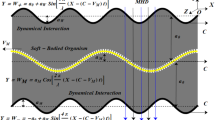Abstract
This paper proposes a novel concept of virus-like swimming robot in the range of nano to micro scales for biomedical applications. Viruses are submicroscopic, intracellular parasites that consist of nucleic acid genome and protein capsid. Their shapes help them to move within the infected host organisms and attach to host cells. In this paper, main geometrical features of the viral structure are utilized for conceptual design of the virus-inspired swimming robot and resultant thorny spherical shaped body is equipped with a new inclined and concentric multi-flagella propulsion system for operation in low Reynolds number fluid flow environment. In off-propulsion situation a theoretical formula is derived for thrust value estimation. On the other hand, to investigate the robot behavior in the fluid media in on-propulsion condition, flow field around the robot is simulated using a numerical strategy consisting of surface methods of regularized Stokeslet and Rotlet theory. For propulsion control of the robot a multilayer artificial neural network is designed and employed then flow field of the robot wake is analyzed using Lagrangian Coherent Structure (LCS) concept. Furthermore, potential characteristics and specific features of this kind of miniature robots are discussed as well as its application. The results indicate the capability of the miniature robot to perform complex missions in low Reynolds number fluid flow environment especially bodily fluid systems including lymphatic, urinary and cerebrospinal fluid (CSF) systems.
Similar content being viewed by others
References
Purcell E M. Life at low Reynolds number. Am J Phys, 1977, 45: 3–11
Honda T, Arai K, Ishiyama K. Effect of micro machine shape on swimming properties of the spiral-type magnetic micro-machine. IEEE T Magn, 1999, 35: 3688–3690
Guo S, Hasegaw Y, Fukuda T, et al. Fish-like underwater microrobot with multi DOF. In: Proceedings of International Symposium on Micromechatronics and Human Science, IEEE, 2001. 63–68
MacIver M A, Fontaine E, Burdick J W. Designing future underwater vehicles: principles and mechanisms of weakly electric fish. IEEE J Ocean Eng, 2004, 29: 651–659
Taheri A, Mohammadi-Amin M, Orangi S, et al. An undulatory ribbon-fin design optimization for bio-inspired swimming robot propulsion. In: Proceeding of the 4th International Symposium on Aero Aqua Bio-Mechanisms (ISABMEC2009), Shanghai, China, 2009. 1–6
Behkam B, Sitti M. Design methodology for biomemitic propulsion of miniature Swimming Robots. J Dyn Syst Meas Control, 2006, 128: l36–143
Flores H, Lobaton E, Mendez-Diez S, et al. A study of bacterial flagellar bundling. B Math Biol, 2005, 67: 137–168
Berg H. The rotary motor of bacterial flagella. Annu Rev Biochem, 2003, 72: 19–54
Taheri A, Mohammadi-Amin M. Towards a multi-flagella architecture for E. Coli inspired swimming microrobot propulsion. Proceeding of 8th World Congress on Computational Mechanics & 5th European Congress on Computational Methods in Applied Sciences and Engineering, Venice, Italy, 2008. 1–2
Taheri A, Mohammadi-Amin M, Moosavy S H. A numerical strategy to design maneuverable micro-biomedical swimming robots based on biomimetic flagellar propulsion. In: Proceeding of World Academy of Science, Engineering and Technology, Paris, France, 2009, 54: 500–504
Anekal S G, Zhu Y, Graham M D, et al. Dynamics of virus spread in the presence of fluid flow. J Integr Biol, 2009, 1: 664–671
Talaro K P. Foundations in microbiology: basic principles. 6th ed, New York: McGraw-Hill Science Engineering Publication, 2006. 159–186
Deserno M. Virus-inspired physics. Dissertation for Ph.D. Degree. Germany: Max-Planck-Institut für Polymerforschung, Ackermannweg, 2006. 1–150
Onaka S. Simple equation giving shapes of various convex polyhedral: the regular polyhedra and polyhedral composed of crystallographically low-index planes. Phil Mag Lett, 2006, 86(3): 175–183
Glass P, Chung H, Washburn N R, et al. Enhanced reversible adhesion of dopamine methacrylamide-coated elastomer microfibrillar structures under wet conditions. Langmuir, 2009, 25: 6607–6612
Ishikawa T, Sekiya G, Imai Y, et al. Hydrodynamic interactions between two swimming bacteria. Biophys J, 2007, 93: 2217–2225
Cortez R. The method of regularized stokeslet. J Sci Comput, 2001, 23: 1204–1225
Yeom J, Agonafer D D, Han J H, et al. Low Reynolds number flow across an array of cylindrical microposts in a microchannel and figure-of-merit analysis of micropost-filled microreactors. J Micromech Microeng, 2009, 19: 1–10
Hancock G. The self-propulsion of microscopic organisms through liquids. Proc R Soc London, 1953, 217: 96–121
Johnson R E, Brokaw C J. Flagellar hydrodynamics: A comparison between resistive-force theory and slender-body theory. Biophysics, 1979, 125: 113–127
Priere D C. A course in fluid mechanics with vector field theory. Course Notes. Pittsburg: Department of Chemical Engineering of Carnegie Mellon University, 2000. 1–100
Sadlo F, Peikert R. Visualizing Lagrangian Coherent Structures and Comparison to Vector Field Topology. Topology-based Methods in Visualization II Book. Heidelberg, Berlin: Springer, 2009. 1–10
Peng J, Dabiri J O. Transport of inertial particles by lagrangian coherent structures: application to predator-prey interaction in jellyfish feedin. J Fluid Mech, 2009, 623: 75–84
Lipinski D, Cardwell B, Mohseni K. A lagrangian analysis of a two-dimensional airfoil with vortex shedding. J Phys A-Math Theor, 2008, 41: 1–22
Wilson M M, Peng J, Dabiri J O, et al. Lagrangian coherent structures in low Reynolds number swimming. J Phys-Condes Mat, 2009, 21: 1–9
Menhaj M B. Computational intelligence: fundamental of neural networks. Tehran: Amirkabir University of Technology Publication, 2000. 1–300
Dixon J, Greiner S, Goshev A, et al. Lymph flow, shear stress, and lymphocyte velocity in rat mesenteric prenodal lymphatics. Microcirculation (Philadelphia), 2006, 1: 597–610
Galie P, Spilker R L. A two-dimensional computational model of lymph transport across primary lymphatic valves. J Biomech Eng, 2009, 131: 1–9
Yoffcy J M, Courtice F C. Lymphatics, Lymph and the Limphonyeloid Complex. London: Academic Press, 1970
Leifson E. Atlas of Bacterial Flagellation. New York: Academic Press, 1960
Author information
Authors and Affiliations
Corresponding author
Additional information
An erratum to this article can be found at http://dx.doi.org/10.1007/s11431-010-4187-x
Rights and permissions
About this article
Cite this article
Taheri, A., Orangi, S. A novel miniature virus-inspired swimming robot for biomedical applications. Sci. China Technol. Sci. 53, 2883–2895 (2010). https://doi.org/10.1007/s11431-010-4126-x
Received:
Accepted:
Published:
Issue Date:
DOI: https://doi.org/10.1007/s11431-010-4126-x




